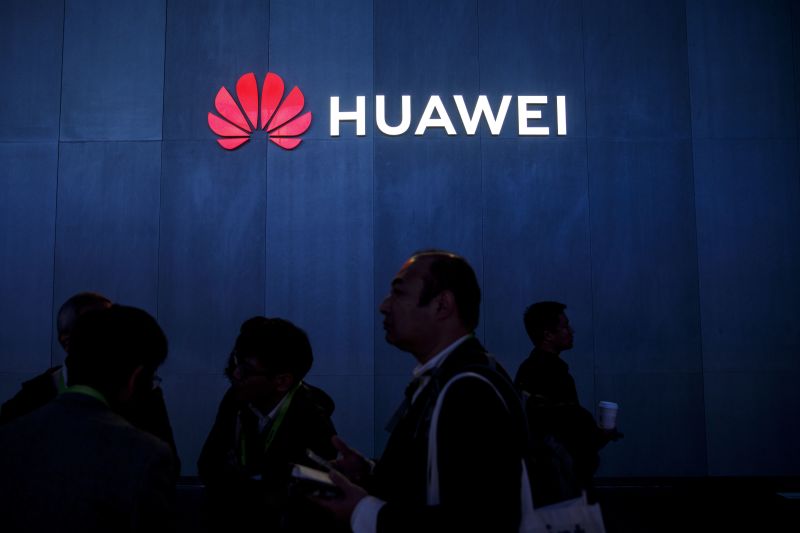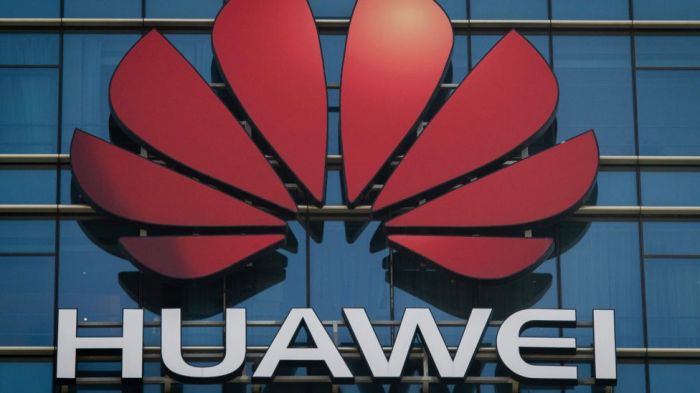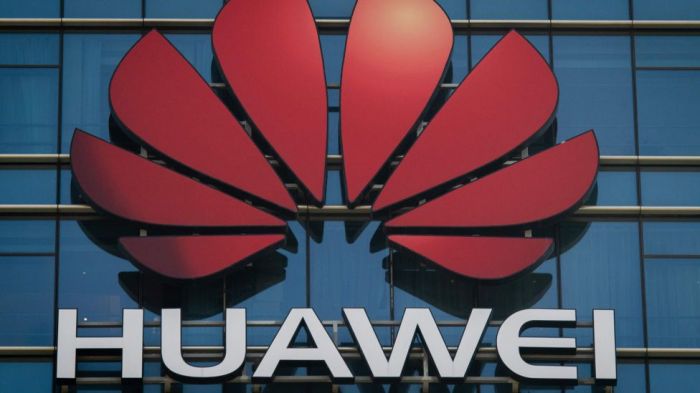Huawei says it can withstand further US escalation, signaling a firm stance in the face of potential trade restrictions and sanctions. The company’s strategy to mitigate risks, including diversifying supply chains and forging international partnerships, is key to understanding its resilience. This article delves into Huawei’s public statements, potential US actions, and the global implications of this escalating conflict.
Huawei’s past interactions with the US government have shaped its current approach. This includes their responses to past sanctions, and the potential economic impact on Huawei should further escalation occur. This analysis explores the different strategies Huawei has employed to minimize the effects of any future actions by the US government. Furthermore, it will discuss potential areas of US escalation and the various types of sanctions.
Huawei’s Stance on US Escalation

Huawei’s public statements regarding potential US actions have consistently emphasized its commitment to complying with international regulations while safeguarding its business interests. The company has expressed confidence in its ability to navigate a complex geopolitical landscape and maintain its global presence. Their strategies focus on mitigating risks and ensuring continued operations, even in the face of escalating tensions.Huawei’s approach to mitigating potential US risks is multifaceted.
They have diversified their supply chains to reduce reliance on specific regions, invested heavily in research and development to enhance self-sufficiency, and actively engaged in dialogue with both international and national bodies to clarify their position and seek potential resolutions. These actions demonstrate a proactive strategy to address potential threats.
Summary of Public Statements
Huawei’s public statements have consistently highlighted their adherence to international regulations. They have also emphasized their commitment to ethical business practices and innovation, while simultaneously affirming their determination to defend their rights and interests. These statements serve as a public declaration of their stance in the face of potential US actions.
Strategies for Risk Mitigation
Huawei has adopted a comprehensive strategy to mitigate potential risks stemming from escalating US actions. This includes diversifying its supply chains to reduce dependence on specific regions, fostering strong relationships with international partners, and actively pursuing R&D initiatives to increase self-sufficiency. This multifaceted approach aims to minimize vulnerabilities and safeguard its long-term business operations.
Historical Context of US Interactions
Huawei’s interactions with the US government have been marked by regulatory scrutiny and trade tensions. These tensions stem from concerns about national security and technology competition. Historical actions have included sanctions and restrictions on Huawei’s access to certain technologies and markets. The ongoing interplay between the two entities shapes the current landscape of global technology competition.
Potential Economic Impacts of Escalating US Actions
Escalating US actions could severely impact Huawei’s global market share and profitability. Reduced access to essential technologies, restricted international partnerships, and diminished consumer confidence could lead to substantial economic losses. The impact on employment and economic growth in China could also be significant. For instance, similar restrictions imposed on other companies in the past resulted in considerable market share shifts and financial losses.
Huawei’s Responses to Past US Actions
| US Action | Huawei’s Response |
|---|---|
| Sanctions on US technology exports | Diversified supply chains, accelerated research and development in key technologies, and actively engaged in discussions with international regulatory bodies. |
| Restrictions on access to US markets | Expanded partnerships with other global markets, including Europe and Asia, and pursued aggressive market expansion in regions not affected by US restrictions. |
| Blacklisting by US government agencies | Continued operation by emphasizing global partnerships and focusing on regional growth strategies. |
Potential US Actions and their Impact
Huawei’s relationship with the US government has been fraught with tension, and potential future actions by the US could significantly impact the company’s operations and global presence. The ongoing trade war and accusations of intellectual property theft have created a complex and uncertain landscape. This analysis will explore potential areas of escalation, the different types of sanctions, their effects on Huawei, and the impact of trade restrictions on its global operations.The US government’s actions against Huawei are not merely isolated incidents; they reflect a broader strategic competition between the two countries.
This complex interplay of economic, technological, and geopolitical factors shapes the potential for future US actions and their profound consequences for Huawei.
Potential Areas of Escalation in US-Huawei Relations
The US-China rivalry extends beyond trade disputes and encompasses broader technological and geopolitical competition. Potential areas of escalation include further sanctions targeting Huawei’s supply chain, restrictions on US companies’ collaboration with Huawei, and increased pressure on international allies to limit their engagement with the company. The risk of a complete ban on Huawei’s 5G technology in the US and other countries remains a concern.
Types of US Sanctions and Their Effects on Huawei
US sanctions against Huawei have taken various forms, including restrictions on the export of essential technology, financial sanctions preventing access to US markets and capital, and pressure on allies to implement similar measures. These sanctions aim to curtail Huawei’s technological advancement and market access, hindering its ability to compete effectively. Financial sanctions can severely limit Huawei’s ability to raise capital, impacting its research and development and future growth prospects.
Impact of US Trade Restrictions on Huawei’s Global Operations
US trade restrictions have significantly impacted Huawei’s global operations. The restrictions have affected its ability to source components and technology from US companies, leading to production delays and increased costs. This has also affected its ability to collaborate with US-based partners, impacting its technological advancement and global market share. These restrictions have forced Huawei to seek alternative suppliers and partners, leading to a greater dependence on other countries and potentially impacting the supply chain’s resilience.
Huawei’s claim to withstand further US escalation is interesting, considering their impressive advancements in mobile technology. For example, if you’re comparing flagship phone cameras, the Huawei P30 Pro holds its own against the likes of the iPhone 11 Pro, Galaxy Note 10, and Google Pixel 3, as seen in this detailed camera comparison iphone 11 pro galaxy note 10 huawei p30 pro google pixel 3.
This technological prowess could potentially be a key factor in their ability to navigate these geopolitical tensions. It’s all very fascinating, isn’t it?
Comparison of Potential Impact on Different Parts of Huawei’s Business
The impact of potential US actions varies across Huawei’s different business segments. For example, restrictions on US technology would have a greater impact on Huawei’s telecommunications equipment business, as this segment heavily relies on US-origin components. The impact on Huawei’s consumer electronics business, such as smartphones, would also be significant but less direct. The impact on Huawei’s cloud and data center business, however, could be less immediate.
The diversification of supply chains and reliance on other markets is crucial for mitigating the potential impact.
Chronological Order of Significant US Actions Against Huawei and Their Responses
| Date | US Action | Huawei Response |
|---|---|---|
| 2019 | Inclusion in Entity List, Export Controls | Diversification of supply chain, investment in R&D |
| 2020 | Financial Sanctions, Increased Pressure on Allies | Strengthening relationships with other countries, exploring alternative markets |
| 2021 | Further Restrictions on Technology Exports | Continued efforts to develop independent technology, explore new markets |
Global Implications of the Conflict
The US-Huawei conflict has rippled through the global technology landscape, impacting trade, investment, and the development of crucial technologies like 5G. This escalating tension has prompted significant reactions from various nations, forcing a re-evaluation of global supply chains and influencing the future of technological advancement. Understanding these ramifications is critical to comprehending the broader geopolitical implications.The conflict’s influence extends beyond the direct participants, creating a complex web of interconnected consequences that touch every facet of the global tech industry.
Huawei’s claim of withstanding further US escalation is interesting, but honestly, I’m more focused on practical tech solutions right now. A great example of a useful gadget is the satechi double sided wireless charger apple watch airpods. It’s a sleek and efficient way to keep my Apple Watch and AirPods charged, and it’s perfect for my current setup.
Maybe that’s why Huawei’s confidence seems justified; they’re likely focused on the smaller, day-to-day wins, while the big political picture plays out.
The conflict is forcing nations to recalibrate their technological strategies, potentially leading to fragmentation and diversification in the global tech market. This dynamic has profound implications for international relations and economic stability.
Global Tech Landscape’s Reaction
The US-Huawei conflict has spurred a multifaceted response from the global tech community. Many countries, particularly those with close ties to the US, have adopted cautious approaches, often implementing export controls or restricting Huawei’s involvement in their 5G networks. This reflects a growing awareness of the potential security risks associated with certain technologies. Conversely, other countries, particularly those with a strategic interest in 5G development or a desire for technological independence, have been less hesitant to partner with Huawei.
This divergence in response highlights the complex geopolitical landscape and the trade-offs involved in technological advancement.
Influence on Global Trade and Investment
The conflict has profoundly impacted global trade and investment, particularly in the telecommunications sector. Restrictions on US companies working with Huawei have created uncertainty and hindered cross-border cooperation. The US’s actions have prompted other countries to reassess their trade relationships and potentially seek alternative suppliers, potentially leading to the fragmentation of global supply chains. This shift has created an environment of uncertainty and caution in global investment decisions, impacting the pace of technological development and innovation.
Other Nations’ Responses
Countries have adopted varying strategies in response to the US-Huawei conflict. Some have opted for a cautious approach, prioritizing security concerns and adhering to US regulations. Others have sought to maintain or expand their partnerships with Huawei, recognizing the potential economic benefits. This diverse response underscores the delicate balance between security considerations, economic interests, and technological advancement. For example, some countries have started exploring partnerships with other technology providers to reduce their reliance on US or Chinese companies.
Impact on 5G and Emerging Technologies
The conflict has significantly influenced the development and deployment of 5G and other emerging technologies. The US-imposed restrictions on Huawei’s participation in 5G infrastructure have forced some countries to rethink their strategies. This has led to delays in 5G deployment in certain regions and a potential shift in the global 5G landscape. In addition, the conflict has sparked a global discussion about the balance between security and innovation in the development of future technologies.
For example, several countries are now investigating alternative approaches to 5G technology to reduce reliance on specific vendors.
Impact on Global Supply Chains
The US-Huawei conflict has had a substantial impact on global supply chains, particularly in the technology sector. The restrictions on Huawei’s access to components and technology have created disruptions in supply chains, potentially increasing costs and slowing down the pace of technological advancement. This has prompted companies to diversify their sourcing strategies, leading to increased complexity and potentially higher costs.
For instance, companies may need to develop multiple sourcing options to avoid dependence on a single supplier. This highlights the interconnectedness of global supply chains and the potential for disruptions in the event of geopolitical tensions.
Huawei’s Resilience and Strategies
Huawei’s journey through a challenging geopolitical landscape underscores its remarkable resilience. Facing escalating US pressure and trade restrictions, Huawei has demonstrated a proactive approach to navigating adversity, emphasizing diversification and internal adaptability. This proactive response highlights its commitment to long-term sustainability and global competitiveness.
Diversifying Supply Chains
Huawei has actively pursued diversification strategies to reduce its reliance on US technology. This includes establishing partnerships with suppliers in different countries, particularly in Asia and Europe. The aim is to create a more robust and less vulnerable supply chain. This strategic move is crucial for ensuring continuity of operations and minimizing disruptions.
- Huawei has actively sought alternative suppliers for components and materials, expanding its network beyond traditional US-based vendors. This has involved collaborations with companies in countries like South Korea, Japan, and Taiwan.
- The company has also invested in developing in-house capabilities for crucial technologies, reducing its dependence on external sources. This includes developing its own semiconductor design and manufacturing processes.
Adapting to Shifting Geopolitical Landscapes, Huawei says it can withstand further us escalation
Huawei’s internal processes have adapted to the evolving geopolitical landscape. This includes scenario planning, risk assessment, and contingency strategies. These measures allow Huawei to anticipate and prepare for potential challenges and adjust its operations accordingly. This proactive approach demonstrates a clear understanding of the global environment and the need for flexible responses.
- Huawei’s internal decision-making processes have incorporated geopolitical risk assessments into their strategic planning, ensuring potential disruptions are factored in.
- The company has established contingency plans for various scenarios, including supply chain disruptions and regulatory changes. This allows for rapid response and operational continuity.
Adapting Business Models
Huawei has adjusted its business models to navigate the evolving challenges. This includes exploring new markets and partnerships, while maintaining a focus on its core competencies. This flexibility allows Huawei to capitalize on opportunities and maintain competitiveness.
- Huawei has expanded its presence in emerging markets, diversifying its revenue streams and reducing its reliance on mature economies.
- The company has focused on developing partnerships with local companies in new markets, leveraging local expertise and infrastructure.
Resilience Comparison
| Company | Supply Chain Diversification | Geopolitical Adaptation | Business Model Flexibility |
|---|---|---|---|
| Huawei | High, establishing partnerships in multiple regions | High, comprehensive risk assessment and contingency plans | High, expanding into new markets and partnerships |
| Samsung | Medium, significant reliance on South Korea | Medium, but strong in South Korea | High, expanding into various product segments |
| Apple | Low, primarily relying on US and Asian partners | Medium, strong presence in established markets | High, focusing on design and premium pricing |
| Medium, diversifying but reliant on US infrastructure | Medium, strong reliance on US innovation | High, adapting to changing market needs |
Alternative Perspectives and Analysis: Huawei Says It Can Withstand Further Us Escalation
The US-Huawei conflict, a complex interplay of economic, technological, and geopolitical forces, sparks diverse opinions on Huawei’s resilience. While Huawei asserts its ability to navigate the escalating pressure, critics question its long-term viability under sustained US sanctions and technological blockades. This section explores these contrasting perspectives, examining alternative solutions and potential long-term impacts on the global tech landscape.The differing viewpoints on Huawei’s capacity to withstand US pressure stem from various factors.
Supporters highlight Huawei’s robust domestic market, extensive global network, and innovative R&D efforts as strengths that allow it to adapt and overcome challenges. Conversely, critics emphasize the severe limitations imposed by US sanctions, particularly in accessing critical technologies and global supply chains, arguing that Huawei’s ability to fully compensate for these losses is uncertain.
Huawei’s claims of resilience against further US escalation are interesting, but perhaps the real tech drama is unfolding elsewhere. For instance, Meta’s decision not to offer trade-ins for the Quest 2 when upgrading to the Quest 3, as detailed in this article meta wont offer quest 2 trade ins for quest 3 , highlights a different kind of challenge in the tech world.
Still, Huawei’s apparent ability to weather the storm remains a significant point of interest, regardless of the trade-in policies of consumer tech companies.
Differing Opinions on Huawei’s Resilience
The debate surrounding Huawei’s resilience centers on contrasting assessments of its technological capabilities and strategic adaptability. Proponents of Huawei’s position often cite its substantial domestic market share and strong R&D investments as evidence of its ability to diversify and mitigate external pressures. Conversely, critics emphasize the significant dependencies on foreign technology, highlighting the vulnerability of Huawei’s ecosystem under US sanctions.
Key Arguments Supporting and Opposing Huawei’s Position
The arguments supporting Huawei’s resilience often focus on its significant domestic market penetration, allowing for internal supply chain diversification. Moreover, strong R&D efforts in areas like 5G and cloud computing demonstrate a commitment to innovation and self-reliance. In contrast, opponents argue that the extent of self-sufficiency is limited and that reliance on global supply chains remains crucial for Huawei’s technological advancement.
This creates a vulnerability that US sanctions effectively exploit.
Alternative Solutions to the US-Huawei Conflict
Exploring alternative solutions to the US-Huawei conflict necessitates a nuanced approach. A potential pathway involves fostering greater transparency and accountability in global technology standards and trade practices. This could involve multilateral agreements that aim to mitigate the risks of technology monopolies and promote a more equitable global tech environment. Another approach is promoting independent research and development efforts in countries that are currently reliant on US technology.
Potential Long-Term Implications on the Global Tech Sector
The US-Huawei conflict has far-reaching implications for the global tech sector. A prolonged confrontation could hinder innovation and drive fragmentation, leading to the development of separate technological ecosystems. This could result in increased costs for consumers and reduced interoperability across different systems. The long-term impact on global supply chains and technological development is still largely uncertain, but it is clear that the conflict will have a significant and lasting impact.
Table Outlining Pros and Cons of Different Approaches
| Approach | Pros | Cons |
|---|---|---|
| Increased Transparency and Accountability | Potential for a more equitable global tech environment, reduced risks of technology monopolies, promoting innovation. | Requires significant cooperation and trust from all stakeholders, potential for slow progress. |
| Promoting Independent Research and Development | Reduces dependence on dominant tech players, fostering technological diversity, potentially strengthening global economic resilience. | Requires substantial investment and time, may not be a quick solution, potential for less efficient development. |
| Negotiated Resolution | Could potentially create a framework for cooperation and mitigate the risk of a complete technology split, promoting international stability. | Requires mutual concessions and compromises, potential for delays or failure to reach an agreement. |
Huawei’s International Partnerships
Huawei’s global presence hinges significantly on its robust network of international partnerships. These alliances extend beyond simple business deals, often intertwining with shared technological development and strategic market penetration. Understanding these partnerships is crucial to assessing Huawei’s resilience against potential external pressures.International partnerships are vital for Huawei’s growth and ability to navigate complex geopolitical landscapes. These partnerships are not merely transactional; they represent strategic collaborations that can provide access to resources, expertise, and markets unavailable to a company operating in isolation.
The strength and breadth of these relationships directly influence Huawei’s capacity to withstand external pressures, particularly those emanating from countries like the United States.
Strategies for Building and Maintaining Partnerships
Huawei employs a multi-faceted approach to cultivate and maintain international partnerships. This includes leveraging its technological prowess, offering competitive pricing and terms, and demonstrating a commitment to shared development goals. In essence, Huawei’s strategy focuses on building trust and mutual benefit. This approach has proven successful in establishing partnerships across various sectors and geographical regions.
Impact of Partnerships on Withstanding US Pressure
Partnerships act as a crucial buffer against US pressure. By diversifying its supply chains and market access, Huawei reduces its reliance on a single market or technology source. This diversification enhances its resilience against potential sanctions or trade restrictions. For example, a robust partnership with a European telecommunications provider can provide alternative access to crucial components or markets.
Furthermore, collaborative research and development with international partners can help circumvent US technology restrictions, potentially accelerating the development of new technologies.
Importance in Global Technology Development
Huawei’s international partnerships play a critical role in fostering global technological advancement. By collaborating with companies and research institutions worldwide, Huawei contributes to a shared knowledge pool and accelerates the pace of innovation. This shared knowledge leads to advancements in various fields, from 5G technology to cloud computing. Such collaboration fosters a dynamic and interconnected global technology ecosystem.
Examples of Successful International Partnerships
Huawei has forged successful partnerships across multiple sectors and continents. For example, collaborations with major telecom operators in Europe and Asia have significantly expanded Huawei’s market presence and technological reach. Moreover, joint ventures and research collaborations with academic institutions and other technology companies have contributed to the development of cutting-edge technologies.
Key International Partnerships and Potential Roles
| Partner | Potential Role in Future Developments |
|---|---|
| European Telecommunications Operators | Access to European markets and technology expertise, potentially mitigating US-imposed restrictions. |
| Asian Telecom Providers | Access to large Asian markets and potentially alternative sources of components. |
| Research Institutions (e.g., universities) | Shared knowledge, R&D, and talent acquisition, accelerating technological advancement in 5G and other areas. |
| Other Technology Companies | Joint ventures, cross-licensing, and collaborative research to overcome technological limitations imposed by the US. |
Final Wrap-Up

Huawei’s assertion that it can withstand further US escalation highlights the complex and multifaceted nature of the US-Huawei conflict. The global tech landscape is reacting in various ways, and the impact on global trade and investment is undeniable. This conflict has implications for emerging technologies like 5G, and supply chains worldwide are being affected. Ultimately, the long-term consequences of this ongoing conflict remain uncertain, and alternative solutions should be considered.












